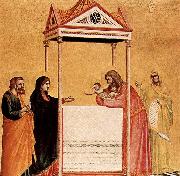
Oil On
Canvas, Real Flavor of Old Masters
|
Lochner, Stephan
|
|||
|
|
|||
| German Northern Renaissance Painter, ca.1400-1451 | |||
|
|
|||
|
|
Presentation in the Temple new5/Lochner, Stephan_CyFM9k.jpg Painting ID:: 19199 Visit European Gallery |
1447, Mixed technique on wood, Hessisches Landesmuseum, Darmstadt. | |
Height Width |
INS/CM |
||
|
X |
|
||
|
|
|||
|
GIOTTO di Bondone
|
|||
|
|
|||
| Italian Early Renaissance Painter, 1267-1337 Italian painter and designer. In his own time and place he had an unrivalled reputation as the best painter and as an innovator, superior to all his predecessors, and he became the first post-Classical artist whose fame extended beyond his lifetime and native city. This was partly the consequence of the rich literary culture of two of the cities where he worked, Padua and Florence. Writing on art in Florence was pioneered by gifted authors and, although not quite art criticism, it involved the comparison of local artists in terms of quality. The most famous single appreciation is found in Dante's verses (Purgatory x) of 1315 or earlier. Exemplifying the transience of fame, first with poets and manuscript illuminators, Dante then remarked that the fame of Cimabue, who had supposed himself to be the leader in painting, had now been displaced by Giotto. Ironically, this text was one factor that forestalled the similar eclipse of Giotto's fame, which was clearly implied by the poet. | |||
|
|
|||
|
|
Presentation in the Temple new16/GIOTTO di Bondone-687458.jpg Painting ID:: 44325 Visit European Gallery |
1320-25 Tempera on wood, 44 x 43 | |
Height Width |
INS/CM |
||
|
X |
|
||
|
|
|||
|
Gerbrand van den Eeckhout
|
|||
|
|
|||
| 1621-1674 Dutch Gerbrand van den Eeckhout Location Dutch painter, draughtsman and etcher. He was the son of the goldsmith Jan Pietersz. van den Eeckhout and a great friend as well as a pupil of Rembrandt, according to Houbraken, who commented that van den Eeckhout painted in the style of his master throughout his career. This is certainly true of van den Eeckhout (biblical) history paintings, but less so of either his portraits, which gradually displayed more Flemish elegance, or his genre pieces (from 1650), in which he followed various trends; he adapted his style to suit his subject with sensitive versatility. He was also a gifted colourist and an artist of great imagination, superior in both these respects to such better-known Rembrandt pupils as Ferdinand Bol and Nicolaes Maes. Moreover, he was extremely productive, and there is at least one dated painting for virtually every year between 1641 and 1674. In addition, he created a large body of drawings comprising histories, figures, landscapes and genre scenes executed in various media, including watercolour. He also made several etchings, mostly studies of heads, such as the Self-portrait (1646; B. 66). He died a bachelor, aged 53. | |||
|
|
|||
|
|
Presentation in the Temple new25/Gerbrand van den Eeckhout-484359.jpg Painting ID:: 84517 Visit European Gallery |
Date 1671(1671) Medium Oil on wood Dimensions Height: 59 cm (23.2 in). Width: 48.5 cm (19.1 in). cjr | |
Height Width |
INS/CM |
||
|
X |
|
||
|
|
|||
|
Gerbrand van den Eeckhout
|
|||
|
|
|||
| 1621-1674 Dutch Gerbrand van den Eeckhout Location Dutch painter, draughtsman and etcher. He was the son of the goldsmith Jan Pietersz. van den Eeckhout and a great friend as well as a pupil of Rembrandt, according to Houbraken, who commented that van den Eeckhout painted in the style of his master throughout his career. This is certainly true of van den Eeckhout (biblical) history paintings, but less so of either his portraits, which gradually displayed more Flemish elegance, or his genre pieces (from 1650), in which he followed various trends; he adapted his style to suit his subject with sensitive versatility. He was also a gifted colourist and an artist of great imagination, superior in both these respects to such better-known Rembrandt pupils as Ferdinand Bol and Nicolaes Maes. Moreover, he was extremely productive, and there is at least one dated painting for virtually every year between 1641 and 1674. In addition, he created a large body of drawings comprising histories, figures, landscapes and genre scenes executed in various media, including watercolour. He also made several etchings, mostly studies of heads, such as the Self-portrait (1646; B. 66). He died a bachelor, aged 53. | |||
|
|
|||
|
|
Presentation in the Temple new25/Gerbrand van den Eeckhout-397498.jpg Painting ID:: 88368 Visit European Gallery |
1671(1671) Medium Oil on wood cyf | |
Height Width |
INS/CM |
||
|
X |
|
||
|
|
|||










